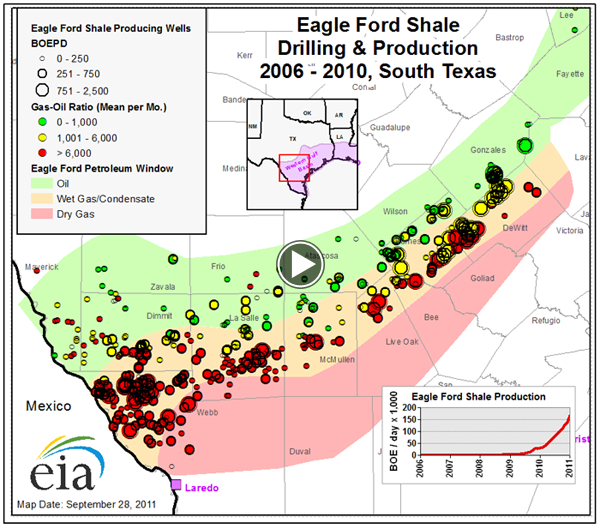
Trends in Eagle Ford drilling highlight the search for oil and natural gas liquids
Eagle Ford Shale Drilling & Production (click image to animate)

Note: Dot color is determined by the well's gas-oil production ratio, or the volume of natural gas produced relative to oil. The higher the ratio (from green to red), the more gas is being produced. Dot size represents the well's production volume: either gas measured in barrels of oil equivalent per day (BOEPD) or oil measured in barrels. The lower right inset graph represents combined oil and natural gas production on a BOEPD basis.
Rapid growth in horizontal drilling at the Eagle Ford shale formation in Texas, like activity described in the previous story on the Bakken formation, has resulted in significant increases in crude oil and natural gas production. Increasing natural gas volumes have also boosted production of lease condensate (recovered as a liquid from natural gas in lease separation facilities) and natural gas liquids (extracted further "downstream" at natural gas processing plants). The animated map shows that the Eagle Ford shale comprises three "windows" (roughly parallel acreage swaths). Production from these windows is increasingly liquids-rich moving generally from south to north. The circular yellow and green producing well markers signify the more "oily" wells, with the red markers representing wells that produce mostly natural gas.
In 2007, total Eagle Ford liquids production (crude oil and condensate) was less than 21 thousand barrels, none of which was from horizontal wells. In 2010, production averaged nearly 29 thousand barrels per day (bbl/d), and was approaching 60 thousand bbl/d by year's end; virtually all was from horizontal wells. Production continues to rise in 2011; according to the Railroad Commission of Texas, Eagle Ford liquids production averaged 74 thousand bbl/d through July.
In major shale plays, drilling activity depends largely on the resource mix and relative fuel prices. For example, drilling in the Barnett shale focuses on natural gas. By contrast, operators in the Bakken formation tend to drill mainly for crude oil. In the Eagle Ford, however, the animation underscores how operators target a combination of crude oil, condensate, and natural gas liquids due to their relative price premium over natural gas.
Tags: crude oil, drilling, liquid fuels, natural gas, oil/petroleum, production/supply, shale, states, Texas